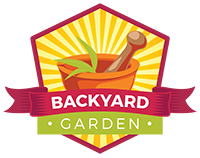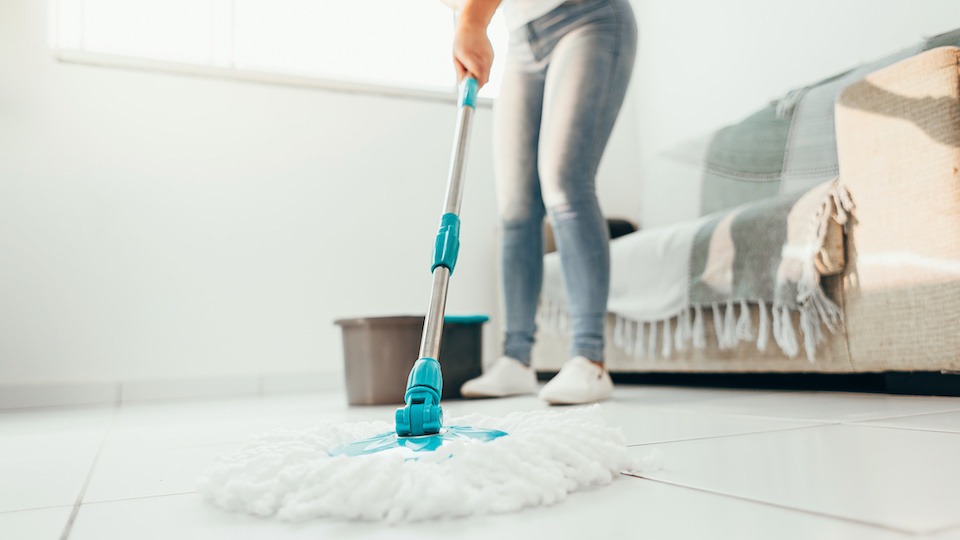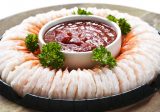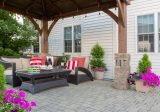If you’re like most people, you probably wash your dishes, wipe down your counters, and empty the garbage can on a regular basis. But, there’s likely a deeper level of grime in your home that you haven’t dealt with for a while.
You’re not alone. You see, we get used to looking past the dirt in our home. But every once in a while, the house needs a real, deep clean to ensure you’re not living with rust, grease, or even mold and mildew.
Once or twice a year, or when special circumstances dictate, a deep clean might be necessary, for example:
- Moving into a new house
- Illness going around
- Pests needing to be cleared out
- Seasonal pollen or dust issues
It’s getting toward that time of year when I like to do a good clean out, and the other day I looked at my kitchen with a “fresh set of eyes,” I was disgusted to see built-up residue at the bottom of the dishwasher, crusted grime in the cracks and crevices of the cabinets, and stains inside the oven.
The old me would have reached for heavy-duty cleaning sprays that cut through all the grease and dirt with industrial-strength chemicals. But the old me also had poor sleep, headaches, allergies, and skewed hormones…
So now, I know better, and I like to clean my home using safe, natural ingredients. Take my word for it: you can get a sparkling clean home WITHOUT the need to use substances that endanger your health.
In the list below, we will go through a process for a full deep-clean, but make sure to focus on items that probably don’t get cleaned very often. This article will teach you how to make the most of your time and clean your house fast. Without any harsh cleaners or toxic chemicals.
First, gather what you will need:
- Vacuum
- Washable cleaning cloths or rags
- Gloves
- Clean cotton socks
- Microfiber mop or duster with telescoping handle
- Non-scratch scrubbing pads
- Old toothbrushes
- Squeegee, if you have one
- Lint roller
- Furniture gliders, if you have them
- Telescoping rod with duster attachments, if you have one
- Step ladder
- Bucket
- Spray bottles
- Caddy or basket
- Baking soda
- Borax
- Castile soap
- Mild natural dishwashing liquid
- Water
- Whole lemon
- White vinegar
- Hydrogen peroxide
- Rubbing alcohol or vodka
- Rosemary sprigs for scent (optional)
- Additional whole lemon or orange for scent (optional)
- Your favorite essential oil for scent (optional)
Now that you’ve gathered your materials let’s get into the deep cleaning process.
Make your cleaners
Since we want to avoid using any toxic cleaning chemicals, prepare these homemade alternatives before beginning the deep-clean. Most of these ingredients are likely already in your kitchen cabinets or can be easily sourced in your local area.
Multi-Purpose Cleaner
Feel free to choose one of the options below based on your preferences and the ingredients you have on hand.
Castile Soap Multi-Purpose Cleaner
This cleaner should be safe to use on any surface, but it’s still a good idea to test in a hidden area first. If you’re using it on marble or granite countertops, avoid choosing citrus essential oils.
Ingredients:
- 2 cups distilled water
- 2 Tbsp castile soap, or up to 1/4 cup if a soapier cleaner is desired
- 15 drops lavender essential oil or peppermint or orange
Instructions:
- Pour the water into a 16-ounce spray bottle (use a funnel, if needed).
- Add the castile soap and essential oil. Gentle shake the cleaner.
- This cleaner may be stored at room temperature. To use: shake gently, spray on, leave it briefly, then wipe off with a damp cloth.
Vinegar Surface Cleaner
This version is good for any surface except granite or marble countertops.
Ingredients:
- 1 cup distilled water
- 1 cup white distilled vinegar
- 15 drops essential oil such as lavender, peppermint, orange or lemon
- Alternatively, if you have time available, place 3 sprigs of fresh rosemary and the peel of 1-2 lemons in a jar with the water and vinegar instead of the essential oils. Let sit for at least a few days, up to a few weeks, before using.
Instructions:
- Pour all the ingredients into a 16 oz spray bottle (use a funnel, if needed).
- Gently shake the cleaner.
- This cleaner will need to be stored in the fridge between uses due to the fresh lemon juice. To use: Gently shake the spray bottle before spraying the cleaner on the desired surface. Spray the cleaner and wipe off the surface with a damp cloth.
Glass Cleaner
Get streak-free shine without that chemical smell.
Ingredients
- 2 cups water
- 1/2 cup white vinegar
- 1/4 cup rubbing alcohol (isopropyl alcohol)
- 1 to 2 drops orange essential oil for smell (optional)
Instructions
- Combine all ingredients in a spray bottle.
- Spray onto windows, glass or mirrors. Hint: Don’t clean windows on a hot, sunny day, because the solution will dry too quickly and leave lots of streaks. For mirrors, spray the solution on a paper towel or soft cloth first before wiping.
Oven Cleaner
Ingredients
- 1 cup baking soda
- 3 Tbsp water
Instructions
- Place the baking soda in a bowl.
- Add the water a little bit at a time and mix carefully until a thick paste is formed. Add more or less water as needed.
Now that you’ve prepared your arsenal of non-toxic homemade cleaners, it’s time to get everything together and get moving.
Gather Your Equipment
Collect your cleaning equipment and put it in one spot to designate as your “Cleaning Central”. If you get everything organized, so you’re not looking for things in the middle of the process, you’ll be more efficient. Then, place your gloves, cloths, scrubbers, brushes and natural cleaners in a caddy which you can bring with you from room to room.
Tidy Up and Declutter
This step is about getting everything out of the way so you’ll have free rein to clean. Find a new place for — or better yet, get rid of — anything that does not belong in the room. Put things away, but try not to stuff them in cupboards or spare rooms, because you’re going to be deep cleaning those too! The best place to put loose items may be outside, so that all surfaces are clear and furniture can be moved around as needed for thorough cleaning.
Dusting and Vacuuming
Here comes our first cleaning task! With each task, it’s best to do it across the whole house, rather than going room by room. So, let’s work from top to bottom. Starting with the highest points (cobwebby corners, and tops of door and window frames) and moving down.
Tackle the big, hard-to-reach surfaces in this order: ceiling, ceiling trim, ceiling light fixtures (including bulbs), walls, the rest of the trim, and baseboards. The best tool to help with this is a clean microfiber mop or duster with a telescoping handle. Above eye level, a spritz of water is all you need on the mop. Remember to dust lights, vents, and fan blades—clean lamps with microfiber cloths or a damp rag. Move every item that is sitting on a shelf and wipe it. Wearing a sock as a “fitted dusting cloth” on your hand is helpful here – keep it damp and rinse and wring often.
Vacuum the space thoroughly, using the crevice attachment for cleaning along baseboards. Use furniture gliders to shift sofas, beds, and dressers, which rarely get cleaned behind or underneath. While you’re at it, you can also vacuum crumbs out of the oven and toaster, get the extra lint out of the dryer, and clean between the couch cushions.
Walls and windows
Walls can get grimy over time from hands touching them, or shoes, bags and furniture bumping them. To clean walls, use warm water mixed with a drop of mild dish soap or castile soap. (In bathrooms, add a splash of white vinegar to stop mold.) Don’t forget about door handles, light switches, and handrails.
For windows: first, vacuum the sills and tracks. Then spritz the window with your natural glass cleaner from top to bottom. Let the cleaner do its thing for a minute, then squeegee it off.
Soft Furnishings
Next, strip all the beds and change the bedding. Sprinkle baking soda on the mattresses and let sit for 30 minutes, then vacuum. Change all the towels, including hand towels and tea towels.
Window treatments can be removed and laundered, fluffed in the dryer to remove dust, or simply vacuumed with the brush attachment. Rugs should be taken outdoors and beaten to remove dust, while furniture can be vacuumed and brushed, using baking soda and water to remove any spot stains. Remove throw pillow covers and throw blankets, and launder (taking appropriate fabric care into account).
And finally, don’t forget to wash all the reusable grocery bags in the house! (when was the last time those ever got washed?)
Hard Surfaces
Use one damp microfiber cloth, followed by one dry cloth in wiping clean all the mirrors and glass surfaces. Go through your house and wipe down the hard surfaces, covering off large areas such as countertops and cabinets, including the handles. Your natural cleaner with vinegar will disinfect surfaces, which is vital to keeping sickness at bay, especially during the winter months.
Next, think about disinfecting places and items that are used or handled often but do not get cleaned regularly, such as recycling bins, compost buckets, and trash cans. If appropriate, take items outside with a large bucket of hot soapy water and scrub down these items, then hose them to rinse.
Use an old toothbrush with some vinegar-based cleaner to scrub along the place where your kitchen cabinets and bathroom vanities meet the floor.
Wet Areas
To clean wet areas efficiently, spray some of your all-purpose cleaner on the kitchen sink, bathroom sinks, tubs, and toilets. Let it sit for a few minutes, then return to the surfaces and start scrubbing. You can also use a lemon to clean the kitchen sink. Just cut in half, sprinkle some salt on top, and rub all over the sink to get it disinfected and shining.
Scrub out shower door tracks and hinges with an old toothbrush. Straight vinegar is good for killing any mold, or you can use baking soda and hydrogen peroxide. Combine the baking soda and hydrogen peroxide to form a paste, and then add it to mold-prone and mold-affected areas in the shower to treat the spots and spores safely. After a few minutes, rinse the area and use a cloth to wipe it clean. Mold-be-gone!
Scrub any tile backsplashes or tiled showers with a toothbrush and your soap-based multi-surface cleaner to remove grime. An easy paste consisting of two parts baking soda mixed with one part hydrogen peroxide offers a chlorine-free and bleach-free alternative to whiten and disinfect grout. Use an old toothbrush to apply it to the grout lines, allow it to sit for a few minutes, and then use the toothbrush again to rinse it away with water. This will brighten dingy white grout and keep mold growth at bay.
A regular spritz of white vinegar will help to prevent build-up on your shower head. For a deep clean, remove the showerhead from the wall (for ease of cleaning), and soak it in a 50/50 white vinegar and water mixture, either in a basin or sealed in a plastic bag. The vinegar will help to loosen the residues on the surface (as well as any clogs inhibiting water flow). After an hour, use a sponge to wipe it, and run water through the spout to clear out all the vinegar.
Don’t overlook the curtain. Remove the shower curtain and plastic liner from the rod. Following manufacturer directions, launder fabric curtain to remove dust, toilet germs, and possible mildew.
Clean toilets last. While you may clean or wipe down your toilet often, the best way to remove germs and viruses is actually to disinfect it. To do this, be sure to leave your cleaning spray on the surfaces for longer (at least 5 minutes), keeping surfaces wet to ensure the germ-killing power has time to work. Then, scrub all of the surfaces and wipe clean and dry.
Tech
This step is a doozy, but it will be worth it to really kick bacteria, dust, and germs out of your home. This approach should be safe for most tech devices: Use a soft-bristled brush to gently remove debris from crevices, followed by a microfiber cloth slightly dampened with rubbing alcohol to cleanse and disinfect. Gently clean and disinfect screens, TV remotes, telephones, smartphones, laptops, headphones, and the like.
Fridge
Next, we have appliances. Clean the inside of the fridge with a solution of two tablespoons baking soda and one-quart hot water. Rinse with a damp cloth, then dry with a towel. Soak the removable sections in the same solution, then scrub, rinse, and dry.
Oven
For the oven, cover surfaces with a thick paste of baking soda and water, and let sit for 20 minutes. Wipe off with a rag using a circular motion. Baking soda can leave a bit of grit in your oven, so spray the oven with white vinegar after wiping out all of the baking soda cleaner. The vinegar will react with any leftover baking soda so you can easily wipe out the bubbling remains. Finish by buffing the oven surface with a damp microfiber rag.
Dishwasher
To clean the dishwasher, fill the detergent holder with white vinegar. Run a heavy clean cycle to let the machine break down any residue and disinfect. Wipe the interior with a warm soapy washcloth. Clean the exterior with warm soapy water and dry thoroughly.
Be sure to wash the filters from your range hood in the dishwasher, and don’t forget to wipe down the inside of the microwave. You can put a mug full of water vinegar in the microwave and cook for 1 minute. It will steam any dried food so you can wipe the inside clean with a paper towel.
Utility Areas
Finally, if you’re not already exhausted, move on to utility areas like the garage, laundry room, and storage areas. Complete similar steps such as shifting items, vacuuming behind and underneath everything, scrubbing down surfaces with a vinegar-based cleaner, and clearing out cluttered storage. If you don’t have a storage system in place, purchase some plastic tote bins for each space to items things clean and organized while minimizing dust.
Sweep and Mop
After all of this cleaning activity, we just need to remove all the dust and debris from the floors. Give everything a quick sweep or final once-over with the vacuum and then mop any hard floors with your all-purpose cleaner.
Here are a few extra tips to help keep your house clean and disinfected at all times:
- Don’t forget to clean your cleaning tools. This is often overlooked, but it’s a major problem! Using a dirty mop or a vacuum with a full bag is much less effective, and you’ll end up spending more time trying to clean while spreading dust and bacteria around your home.
- Make cleaning fun! Making cleaning a team effort is one of the best ways to clean a house fast. Schedule a time in advance with your family, and assign tasks to each person. Working together with some music playing can add some fun to cleaning, and your house will be sparkling in no time. Plan a reward such as a pizza party for the evening when you’ve finished all that hard work.
Using natural ingredients to deep clean your home will go a long way toward keeping your home pleasant to live in, and your family happy and healthy. Now, time to get cleaning!
-The Backyard Garden Team







